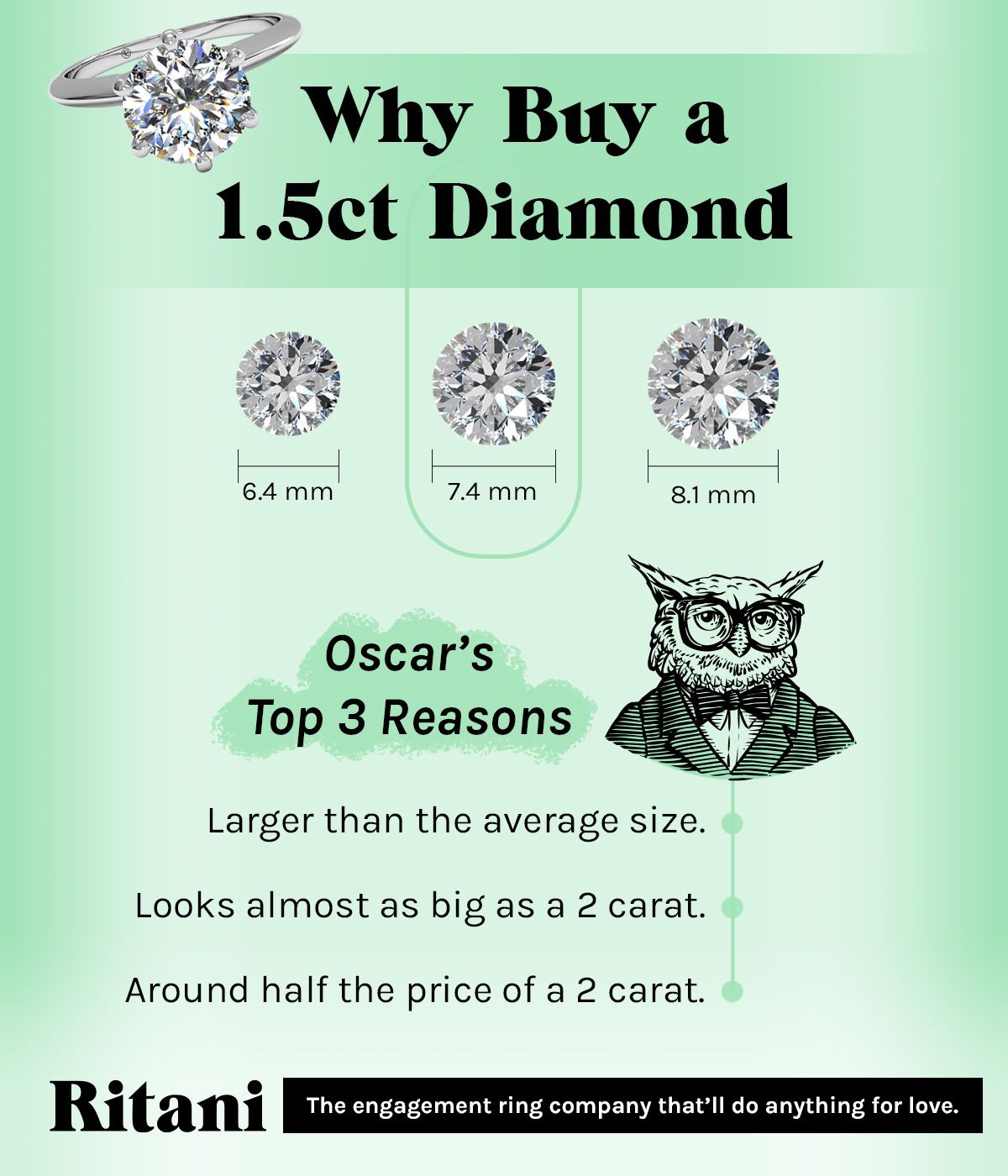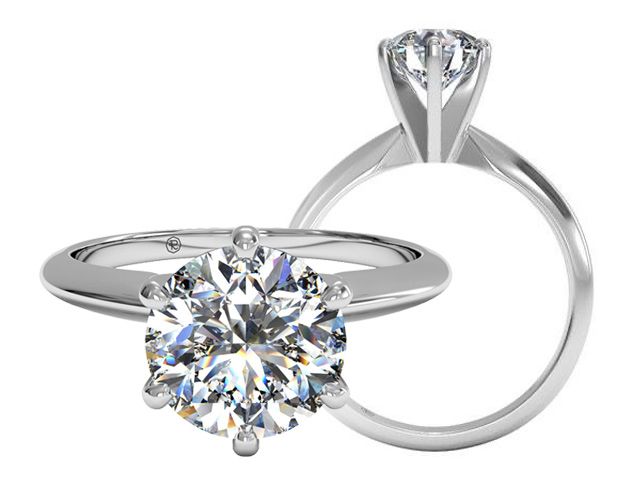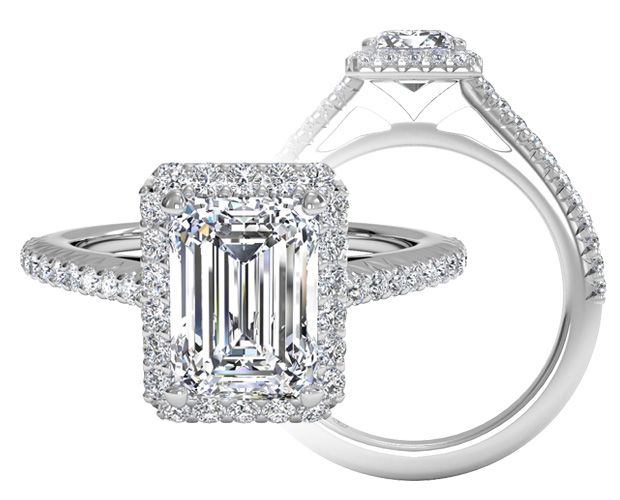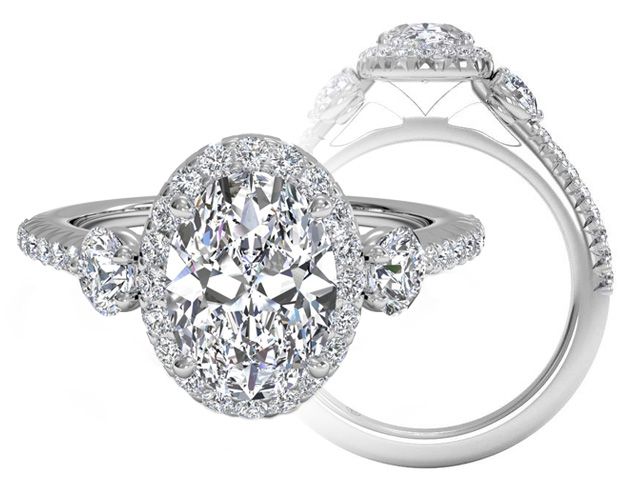August 17, 2022
How to Buy a 1.5 Carat Diamond Ring

If you are looking for an exquisite 1.5-carat diamond engagement ring, you have come to the right place! In this guide, you will find tips and get the information you need to make the most out of your budget to get a beautiful gem—and create the engagement ring of your dreams.
In this guide, you will:
• Learn Why Buying a 1.5 Carat Diamond Is a Good Idea
• Understand What To Look To Maximize Your Budget
• Discover The Best Tips to Create a Gorgeous 1.5 Carat Diamond Engagement Ring
• Find Inspiration in Ritani’s Engagement Ring Settings
There are several reasons why you might go for a smaller or a bigger stone, from budget to personal style. All diamonds are beautiful and unique. That being said, buckle up because this post is going to drive you through all the benefits of buying a 1.5-carat diamond.
3 Reasons to Choose a 1.5 Carat Diamond Engagement Ring

1. Your Diamond Will Look Larger Than Most
The average diamond engagement ring in the US is around 1 carat. With a 1.5 carat diamond, your ring will look more substantial and feel more luxurious. 1.5 carat is the perfect size for many brides: eye-catching without drawing too much attention. The 1.5 carat round diamond. has an average diameter of 7.4mm.
2. They Look Almost the Same As 2 Carat Diamonds
Visually, a 1.5-carat diamond face up doesn’t look that much smaller than a 2-carat diamond. On average, 2-carat round-cut diamonds have an average diameter of 8mm, making them only 0.6mm larger than a 1.5-carat round diamond. With a halo or a thin band, your stone can definitely pass as a 2 carat.
3. With a 1.5-Carat Diamond You Get More For Less
You now know a 1.5-carat diamond will get you a very similar look and feel to a 2 carat, but did you know you get it for half the price or less? The price jump from 1.5 to 2 carats is a big one. A 2-carat diamond can cost you 3x as much as a 1.5 carat diamond with the same color, clarity, and cut grades.
Use Ritani’s Diamond Finder To Find The Perfect 1.5 Carat Diamond For You
How Much Does a 1.5 Carat Diamond Cost?
There’s no magic number or definitive price range. Carat weight is only one part of the equation of variables that impact a diamond’s price. The better the color, cut, and clarity grades, the more expensive your diamond will get. As a reference, at the moment of this writing, you will find 1.5 carat round brilliant diamonds in our Diamond Finder that start at $4,759 for an L, SI2 diamond, and an impressive D, flawless at $29,927.
If the diamond you want is out of your budget, don’t give up just yet! Consider buying a lab-grown diamond; they are genuine diamonds with the same optical and chemical characteristics as mined diamonds at a fraction of the cost. More and more couples are choosing lab-grown diamonds for their engagement ring over mined diamonds.
Read Next: Everything You Need to Know About Manmade Diamonds
What To Look For In a 1.5 Carat Diamond
Great! You have the Carat C figured out. The next step is to consider what you want in terms of color, clarity and cut. Together, they are known as the 4 Cs of Diamonds and are the focus of diamond lab reports.
Color in 1.5 Carat Diamonds
The larger the stone, the easier it is to spot any yellow tints. We recommend staying in the range of G to I - these diamonds will appear colorless and provide the best value. Another trick is to opt for a rose or yellow gold band for J or K diamonds which will be much less expensive, and the warmth of the setting will mask the faint yellow of your diamond.
By going for a lower color grade you can save money and spend it on a better cut and clarity. After all, both variables directly affect a diamond’s brilliance—especially the cut.
Cut in 1.5 Carat Diamonds
Cut is often considered the most important of the 4 Cs. Choose the best cut grade for your diamond to ensure lots of sparkle. A well-cut diamond will also look true to size. Choose an Ideal cut for round-cut diamonds and a Very Good cut for fancy shapes.
Clarity in 1.5 Carat Diamonds
As with color, inclusions will be more noticeable in larger sizes. A safe bet would be to go for a VS1 grade or higher. Yet, there are some tricks you can use to buy a lower clarity grade diamond that still looks clean. If the diamond you’re checking out has a laboratory report, you can see the online version before buying it. The report will have a diagram marking where the inclusions are located in the diamond, face up. As a rule of thumb, if the inclusions are away from the table and closer to the edges, they will be less noticeable. Brilliant cuts like the round, cushion, and radiant hide inclusions better thanks to the smaller size of their facets and higher scintillation.
Get Inspired: Gorgeous Settings For a 1.5 Carat Diamond
A Classic 14kt White Gold Solitaire

You can’t go wrong with the timeless elegance of a solitaire. This setting features a knife-edge band that reflects light in different directions.
Read Next: How to Buy a Solitaire Engagement Ring
Trick The Eye With This Halo Setting

The sparkling row of melee brilliants surrounding a 1.5-carat emerald diamond will create the illusion of a larger stone.
A Three-Stone Setting Will Draw Attention To The Center Stone

In this remarkable 18kt white gold ring, the center oval cut diamond is hugged by a dazzling halo and flanked by two round brilliants at each side.


